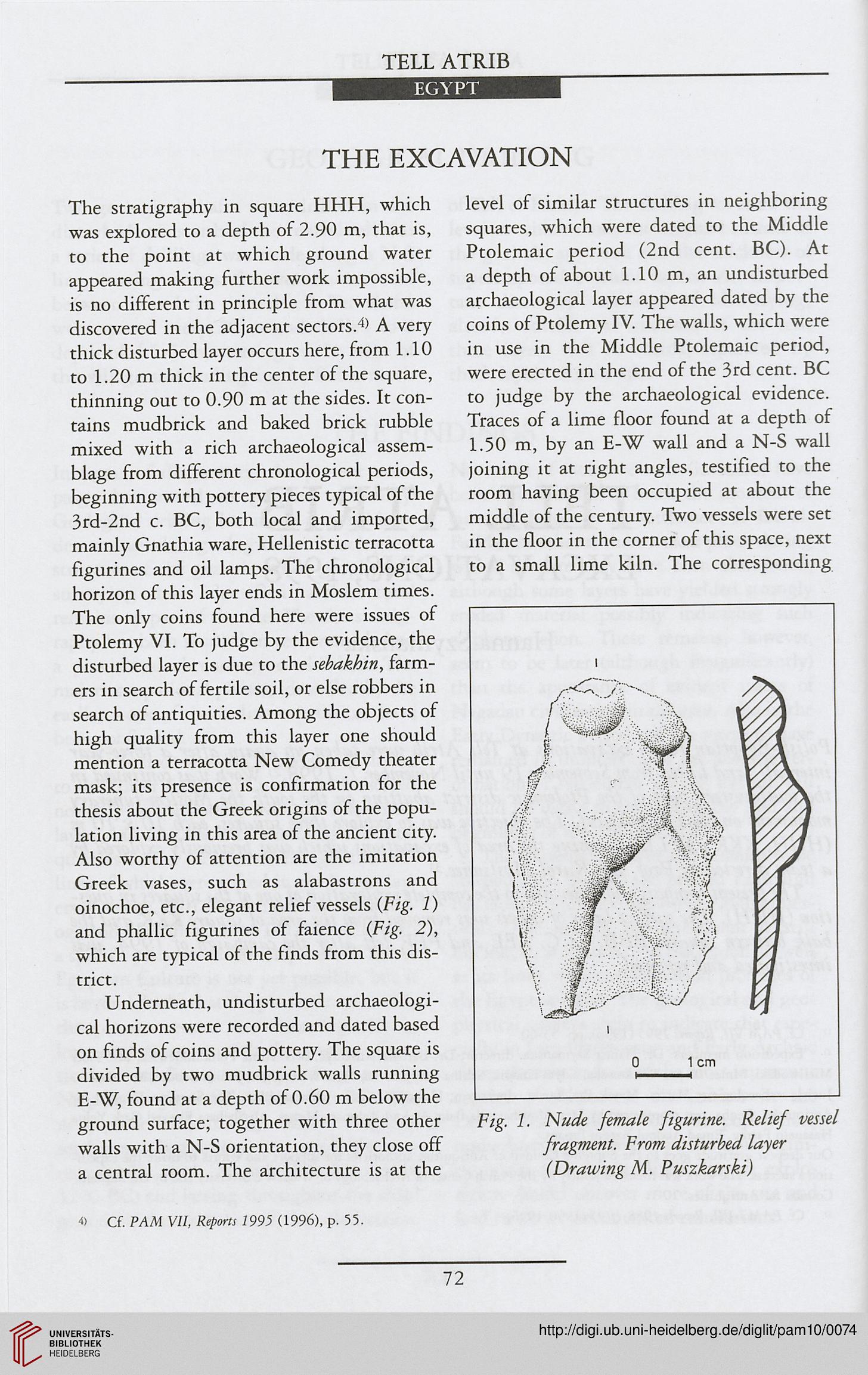TELL ATRIB
EGYPT
THE EXCAVATION
The stratigraphy in square HHH, which
was explored to a depth of 2.90 m, that is,
to the point at which ground water
appeared making further work impossible,
is no different in principle from what was
discovered in the adjacent sectors.4) A very
thick disturbed layer occurs here, from 1.10
to 1.20 m thick in the center of the square,
thinning out to 0.90 m at the sides. It con-
tains mudbrick and baked brick rubble
mixed with a rich archaeological assem-
blage from different chronological periods,
beginning with pottery pieces typical of the
3rd-2nd c. BC, both local and imported,
mainly Gnathia ware, Hellenistic terracotta
figurines and oil lamps. The chronological
horizon of this layer ends in Moslem times.
The only coins found here were issues of
Ptolemy VI. To judge by the evidence, the
disturbed layer is due to the sebakhin, farm-
ers in search of fertile soil, or else robbers in
search of antiquities. Among the objects of
high quality from this layer one should
mention a terracotta New Comedy theater
mask; its presence is confirmation for the
thesis about the Greek origins of the popu-
lation living in this area of the ancient city.
Also worthy of attention are the imitation
Greek vases, such as alabastrons and
oinochoe, etc., elegant relief vessels (Fzg. I)
and phallic figurines of faience (Fig. 2),
which are typical of the finds from this dis-
trict.
Underneath, undisturbed archaeologi-
cal horizons were recorded and dated based
on finds of coins and pottery. The square is
divided by two mudbrick walls running
E-W, found at a depth of 0.60 m below the
ground surface; together with three other
walls with a N-S orientation, they close off
a central room. The architecture is at the
level of similar structures in neighboring
squares, which were dated to the Middle
Ptolemaic period (2nd cent. BC). At
a depth of about 1.10 m, an undisturbed
archaeological layer appeared dated by the
coins of Ptolemy IV. The walls, which were
in use in the Middle Ptolemaic period,
were erected in the end of the 3rd cent. BC
to judge by the archaeological evidence.
Traces of a lime floor found at a depth of
1.50 m, by an E-W wall and a N-S wall
joining it at right angles, testified to the
room having been occupied at about the
middle of the century. Two vessels were set
in the floor in the corner of this space, next
to a small lime kiln. The corresponding
0 1 cm
Fig. 1. Nude female figurine. Relief vessel
fragment. From disturbed layer
(Drawing M. Puszkarski)
« Cf. PAM VII, Reports 1995 (1996), p. 55.
72
EGYPT
THE EXCAVATION
The stratigraphy in square HHH, which
was explored to a depth of 2.90 m, that is,
to the point at which ground water
appeared making further work impossible,
is no different in principle from what was
discovered in the adjacent sectors.4) A very
thick disturbed layer occurs here, from 1.10
to 1.20 m thick in the center of the square,
thinning out to 0.90 m at the sides. It con-
tains mudbrick and baked brick rubble
mixed with a rich archaeological assem-
blage from different chronological periods,
beginning with pottery pieces typical of the
3rd-2nd c. BC, both local and imported,
mainly Gnathia ware, Hellenistic terracotta
figurines and oil lamps. The chronological
horizon of this layer ends in Moslem times.
The only coins found here were issues of
Ptolemy VI. To judge by the evidence, the
disturbed layer is due to the sebakhin, farm-
ers in search of fertile soil, or else robbers in
search of antiquities. Among the objects of
high quality from this layer one should
mention a terracotta New Comedy theater
mask; its presence is confirmation for the
thesis about the Greek origins of the popu-
lation living in this area of the ancient city.
Also worthy of attention are the imitation
Greek vases, such as alabastrons and
oinochoe, etc., elegant relief vessels (Fzg. I)
and phallic figurines of faience (Fig. 2),
which are typical of the finds from this dis-
trict.
Underneath, undisturbed archaeologi-
cal horizons were recorded and dated based
on finds of coins and pottery. The square is
divided by two mudbrick walls running
E-W, found at a depth of 0.60 m below the
ground surface; together with three other
walls with a N-S orientation, they close off
a central room. The architecture is at the
level of similar structures in neighboring
squares, which were dated to the Middle
Ptolemaic period (2nd cent. BC). At
a depth of about 1.10 m, an undisturbed
archaeological layer appeared dated by the
coins of Ptolemy IV. The walls, which were
in use in the Middle Ptolemaic period,
were erected in the end of the 3rd cent. BC
to judge by the archaeological evidence.
Traces of a lime floor found at a depth of
1.50 m, by an E-W wall and a N-S wall
joining it at right angles, testified to the
room having been occupied at about the
middle of the century. Two vessels were set
in the floor in the corner of this space, next
to a small lime kiln. The corresponding
0 1 cm
Fig. 1. Nude female figurine. Relief vessel
fragment. From disturbed layer
(Drawing M. Puszkarski)
« Cf. PAM VII, Reports 1995 (1996), p. 55.
72




